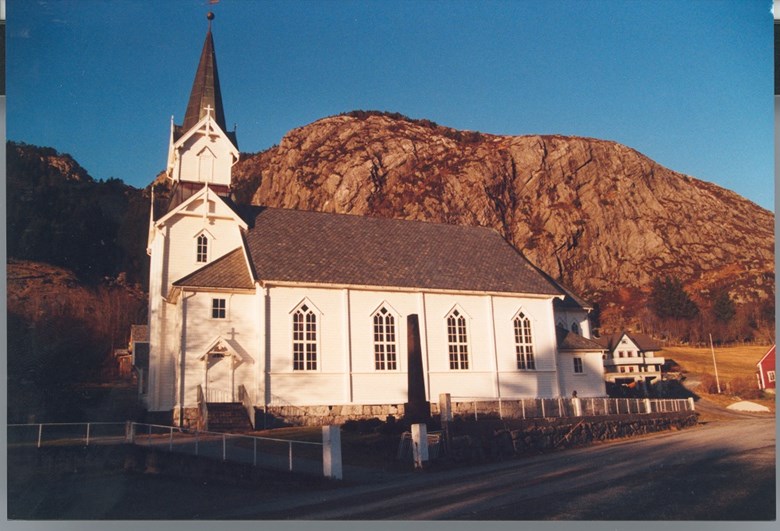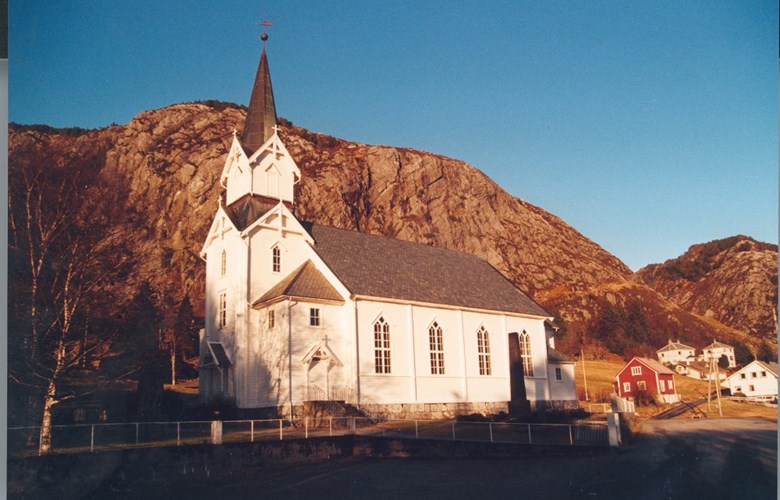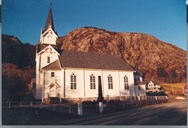A church "sokn" of its own from 1908
If they got a church in their own village, many more people would get the opportunity to listen to the words of the Lord. This was the most important argument used by the people living in the northern part of the island when the work was started in the 1890s to erect a new church in the village. Since the church at Grotle was torn down in 1865, these people had been without a church of their own. Even the vicar had eventually to yield to such a strong argument.
When the church site was moved from Grotle to Frøya, the people who lived further north on the island complained that the journey to church had become too long and strenuous. Going by boat around "Novene" was often a risky undertaking, which kept people from going to church. After a while, a solution to this problem was found when the farms between Vedvik and Nødset were separated from the main "sokn" and a new church was built at Hauge, in the innermost part of the bay of Bremangerpollen. The Bremangerpollen parish of ease was established from 1 July, 1908, and a few days later, the "bedehus" was consecrated for church functions. From the village of Vetvik the journey to church was still more than long enough, and for those who chose not to go by boat, the alternative was a three-hour hike across the mountain.

The interior
Late in the summer of 1914, the Bremangerpollen annexe church was completed. The stones for the foundation wall were taken from the mountain straight up from the church site. This work was carried out on a voluntary basis by the villagers themselves, in addition to the transportation of the wooden building material. The man who had taken on the construction work demanded 30 000 kroner to get the work done, but when the church was completed, he had lost money on the building project.
In terms of the exterior, the chancel addition has the same octagonal form as the one in Frøya church. As for the interior, the altarpiece is another common denominator, but in the case of Bremanger, the motif is painted in a darker colour, and the framework is painted in different colours. In the chancel there are small windows high up on the walls towards the nave, and two large pointed-arch windows on either side of the altar with stained-glass paintings of the four evangelists. The stained-glass paintings were formerly placed up on the chancel wall, but were moved to the chancel windows in 1929, at the same time supplemented with more stained-glass paintings. The four windows on either side of the chancel have the same form as the windows in the nave.
The chancel walls are painted yellow with the wainscot painted in a dark red colour, whereas the wainscot in the nave is painted grey to match the pews. The ceiling is vaulted above the central nave, but flat above the side aisles. The solid carrying construction goes all the way up to the side-aisle ceilings, with two of the girders partially built into the gallery. The arched constructions between the columns and out towards the side walls have dark blue as their dominant colour. A characteristic feature of the colour scheme is the use of violet on the pew ends.
Disagreement of names
Bremanger church was repainted in1952 with the colours it has today. For its 50th anniversary in 1964, electrical heating was installed. The exterior of the church is a beautiful sight, and the unusually elegant steeple catches everybody's eyes. The turret and steeple bases both have gables to the sides with small white crosses on top of the small ridge roofs. The small vestries on either side of the chancel are snugly placed in their respective corners.
Bremanger church is the third church on the Bremangerlandet with the same name. It is the first to be located in the centre of the village, and thus being the church which has best deserved its name. The change of names from Bremangerpollen annexe church to Bremanger church was made effective as of 1 January, 1953, after much disagreement of names which reached a climax in the late 1940s. The church on Frøyalandet, however, kept its position as the main church in the parish as the vicarage was located there.
Art and interior
The altarpiece from 1914 is made by an unknown artist. The motif is the Holy Communion with the text "In remembrance of me" from the Lord's Supper. There was some discussion that year as to the exact wording of the text due to the two variants of the Norwegian language, and the original wording was actually hidden by a painted board with a new text. The matter was settled, however, in November that year when the Bjørgvin Diocese ordered a board to be painted with the original wording and put outside the first board. This arrangement lasted until 1940, when the board was removed and the "New Norwegian" text reappeared.
The antependium from 1980 is made by Kari Egeland. On the altar there are two candlesticks and two candelabras, two of which are made in silver, dating from 1964. The Holy Communion objects consist of a chalice, a dish, a pyx, and a wine cruet from 1953, all in silver. The stained-glass paintings in the chancel windows date from the 1920s. They show portraits of the four evangelists. The pulpit probably dates from 1912, whereas the font is probably from 1914. The baptismal bowl is from 1911, but the holy water ewer is undated.
The organ from 1965 has 15 registers and is made by "Vestre Orgelfabrikk". The church bell from 1914 is made by "Olsen Nauen Klokkestøperi AS", carrying the inscription "Glory to God in the highest".








